Use Case: Tanked Water Heater Leaks
Drops to gallons: early detection is critical for water heater leaks
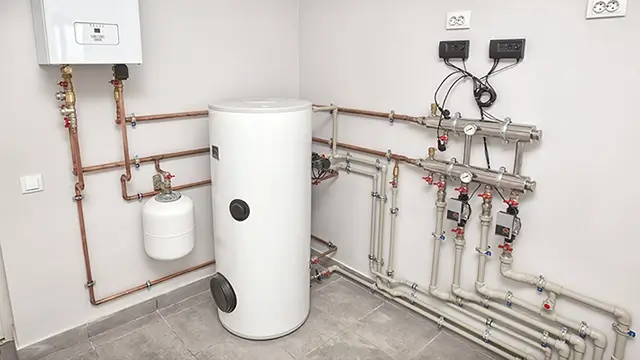
Tanked hot water heaters consist of a cylindrical vessel containing up to 120 gallons of water and can be subject to costly failures. Around 14,000 US homeowners deal with water leak emergencies every day, and hot water tanks are a critical example, considering their higher operating temperatures and pressures.
One particularly serious leak arises from corrosion at the bottom of the tank. Only small amounts of water leak at first, but when a pinhole forms, a catastrophic failure is inevitable. Existing water leak solutions are not sensitive enough to detect the initial signs of these leaks, nor are they suited for the cramped areas around a hot water tank. LAIIER introduces a LoRaWAN® water leak detector that is easy-to-install, thin and wide-covering.
Market opportunity for tanked water heaters
- The global water heater storage tank market is estimated to be worth US$11.5B in 2021.
- 171M units of hot water tanks have been shipped since 2001 in the US alone.
- 75% of water heaters fail before they are 12 years old.
- The average US domestic escape of water (EOW) damage claim is US$6,965.
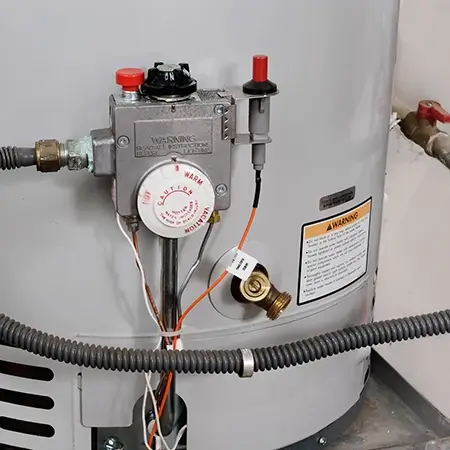
Tanked water heater market dynamics
A tanked water heater keeps water hot and ready to use in a cylindrical metal tank. The heater can be powered by a range of energy sources where gas is found to be the most popular in North America and Europe.
The global water heater market is dominated by the residential segment (overshadowing the commercial and industrial segments) with a revenue share of over 55% in 2019. The residential segment is forecast to keep growing due to the rising accessibility and electrification rate across Asia Pacific and African economies. Geographically, Asia Pacific holds the largest market share at 36.5% of global revenue in 2019, mainly owing to the rapid urbanization of wider infrastructure.
Another significant driver to the hot water storage market is the introduction of more stringent regulations and standards regarding the energy efficiency of electrical appliances. These provisions are particularly seen in Europe and North America and incentivize the installation of tanked heaters as opposed to tankless versions, further increasing this demand.
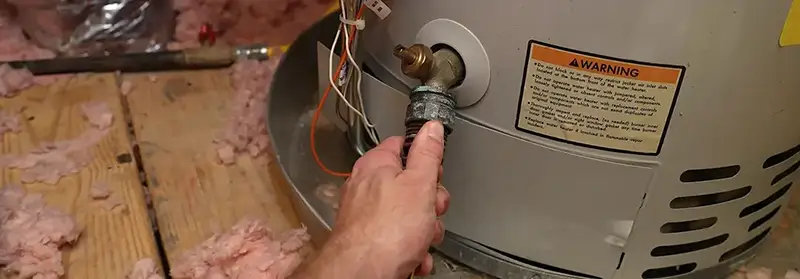
The problem: Hot water tanks have many hard-to-check weak points
Hot water tanks will be a popular and energy-saving option for many homeowners, however, they pose a costly potential of leaking. Out of all the types of leaks in a household, whether a sink or a toilet leak, hot water tank leaks are one of the most expensive, with repairs totaling up to US$1,700. Water heaters have an average lifespan of 12 years but plumbing experts stress the need for a yearly checkup to avoid preventable issues.
The three main types of leaks
The susceptible parts of a hot water heater vary in damage so it is important for homeowners to know what needs to be repaired immediately versus what is a low-priority quick fix. Firstly, above the water heater, water supply lines are the most common type of leak especially if flexible pipes are installed. Supply lines should be checked first as water can sometimes drip down onto the tank and surrounding insulation, making it look like a tank leak.
A hot water tank also has several types of valves and connections such as those used to connect supply-line pipes or drain valves. These components typically have threads that introduce areas of likely leaks. A temperature and pressure (T&P) relief valve, on the other hand, functions to intentionally release water when there is excess temperature or pressure. These leaks should be monitored closely though, as they signify a serious problem elsewhere in the system.
Finally, the worst type of leak originates from the storage tank, as here leaks are usually major outpours rather than small droplets. Corrosion is the main cause of these leaks, and can be accelerated by poor water conditions, for example not replacing sacrificial rods can lead to a build-up of hard water sediment. Eventually, corroded surfaces turn into pinholes which, if left without repair, can rupture a tank, causing a vast amount of water to escape.
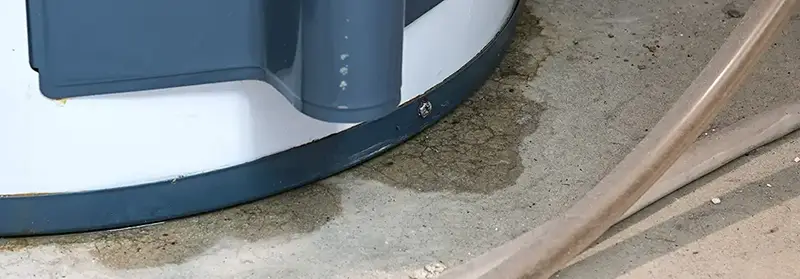
Why damage is hard to prevent
Considering the extent of damage, manual checks are important but are not convenient or useful to do. As detailed, many parts of the hot water tank can leak, so not only do multiple fittings need inspection, but these can be located in hard-to-reach areas. Homeowners may also be discouraged from touching pipes to check for dampness due to hot surfaces in this area. Furthermore, cracks and pinholes may only leak periodically when tanks are under pressure. Therefore, when the tank’s pressure reduces, the leaks stop and cannot be noticed.
Damage, in the case of pinhole leaks, can accumulate substantial costs as tanks must be replaced costing average of US$1,700. The escape of water can further damage surrounding furnishings like fitted units and carpets which may need replacing. Home insurance usually covers the escape of water in sudden events, but not for cases caused by general wear and tear. Even if secondary damage is covered there may be exemption clauses that may, for example, not cover mold that has resulted from the escape of water. This places a large responsibility on homeowners.
Existing solutions for hot water tank leaks
Catching a hot water tank leak early is, therefore, crucial which calls for automatic sensing devices. For residential buildings, there are two main categories of IoT leak detectors: flowmeter and flood sensors. The first category operates by monitoring a plumbing system’s conditions such as internal pressure and flow rate to determine whether there is a leak or not. The downsides to flowmeter-type sensors are that they cannot detect exactly where the leak is coming from and may not flag up the initial drops characteristic of pinhole leaks.
Flood sensors in comparison, are mostly rigid palm-sized pods that are placed next to the potential leak so when water seeps underneath it, this will alert a leak. Although these can be more localized to the hot water tank, its sensing mechanism requires a pool of water which may be activated too late- especially if leaks are coming out as drops from the top of the tank. Furthermore, insulating materials may absorb so much of the leak that no pool is formed.
A sensor that can adapt to the range of surfaces on a hot water tank is needed.
LAIIER’s solution for hot water tanks: A thin, flexible sensor that can cover wide areas
LAIIER has addressed these challenges by creating a thin, flexible sensor that can be installed like a sticker to detect the first drops of a leak. The use of printed electronics means that the sensor can be scaled to cover small or wide areas so specific components such as around pipes, under insulation and at the bottom of the tank can be unobtrusively monitored.
LAIIER’s solution also includes being able to rapidly notify homeowners of any leaks through our Surface to Cloud™ platform utilizing LoRaWAN® technology. This innovative and power-efficient communication network means that battery life can span years minimizing maintenance and installation costs.
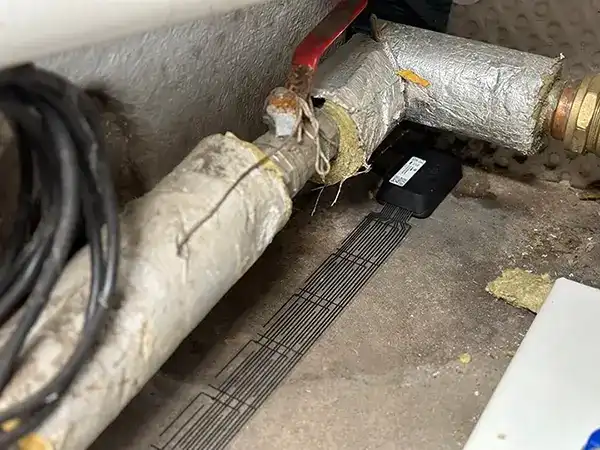
Market demand for hot water tanks
Homeowners and landlords
The damage and potential costs of water tank leaks create a large economic incentive for homeowners to automatically detect issues. Even if small leaks occur, repairing components can mean saving money on electricity and water bills. In the case of hot water tanks, residents may not know how old their tank is, so it may become faulty without homeowners realizing it. Additionally, multi-unit housing such as residential flats are in further danger of leaks as tanks are of higher capacity. Therefore leaks can cause more damage as well as impact multiple property owners.
Residential insurance companies
According to the Insurance Information Institute, about 95% of US homeowners have home insurance, which is around 70M homes. This shows the extent of the insurance market and the importance for insurance companies to understand the potential risks in residential buildings. Currently, many companies restrict EOW policies as serious leaks can lead to costly payouts. However, with LAIIER’s LoRaWAN® water detectors, this can prevent the more severe leaks that arise from hot water tanks and furthermore supply the much-needed data for insurance policymakers who can better predict risks.
Original equipment manufacturers (OEMs)
The water heater market is only predicted to grow, with advancements such as corrosion resistance, water filtration and remote controls boosting their value. By adding a smart water leak detection system, this could increase the value of hot water tanks for leading manufacturers. Key players in the market include Robert Bosch LLC, Whirlpool Corporation, and Noritz Corporation.
Hot water tanks are an essential part of most households yet present a range of complex ways in which water leaks can form. Leaks range from dripping and spraying at valves to the worst-case scenario of a tank rupture. Regardless of this damage, almost all of these leaks have an early window of dripping which is a crucial sign to act- particularly in the case of pinholes. The tight and irregular spaces around a hot water tank mean existing methods cannot effectively detect these first signs.
Here, LAIIER presents a LoRaWAN water leak detector that can be placed underneath water tanks or around other susceptible areas to catch the first signs of a leak. This proactive measure can save homeowners and insurance companies thousands in expenses and keep stakeholders in control.